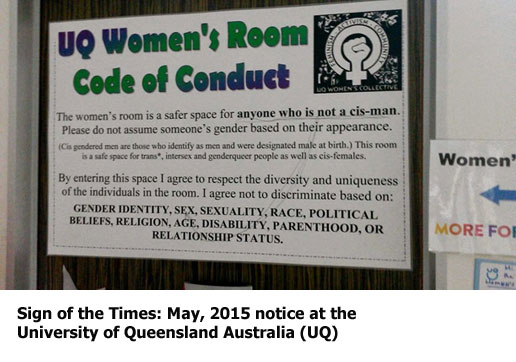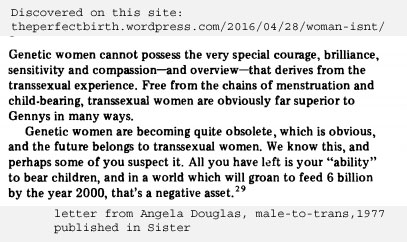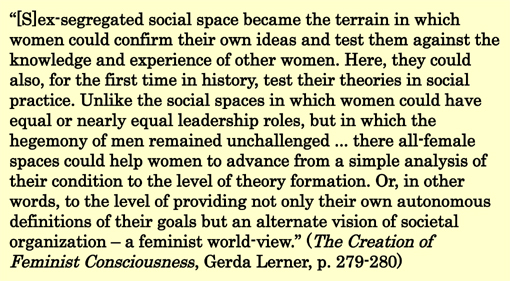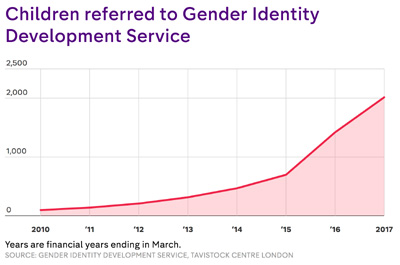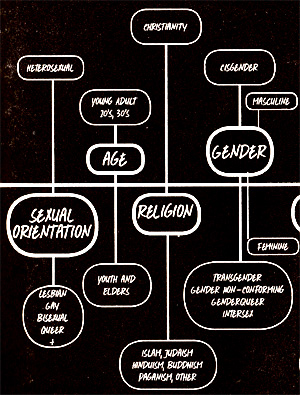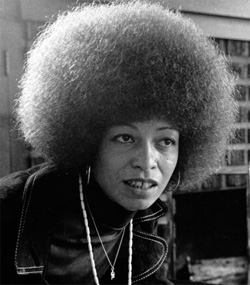By Jeanne F. Neath
We are living in strange times. We are facing a future of ecological disaster and probable social collapse. Our best hope is that resistance movements will succeed in forcing drastic change on global societies.  We are standing up against the powerful people and corporations determined to maintain the deadly and profitable status quo.
We are standing up against the powerful people and corporations determined to maintain the deadly and profitable status quo.
I can’t help wondering if the peculiar ideas pushed by the transgender movement are related to the ways many people in the industrialized world live in denial about the climate and ecological chaos underway. Why expect transgender people to respect the realities of their male and female bodies when they are living in a society where politicians, media, pundits and Internet “influencers” routinely distort and deny reality? Perhaps in a world that wasn’t on the brink of collapse, M2T (male to transgender) people would not be making the impossible claim that they can become women and there would be no conflict between transactivists and radical feminists. Yet, thanks to transactivists, here we are with our women’s voices suppressed to the detriment of women, the Earth and all of life.
Justice for Everyone
 In her book, On Fire: The Burning Case for a Green New Deal, Naomi Klein makes it clear that building a social movement based in justice for everyone is the only way to stop the social forces bent on delivering us to disaster:
In her book, On Fire: The Burning Case for a Green New Deal, Naomi Klein makes it clear that building a social movement based in justice for everyone is the only way to stop the social forces bent on delivering us to disaster:
“To change everything, it takes everyone….
[J]ustice in the here and now is the only thing that has ever motivated popular movements to throw heart and soul into struggle…. It’s the thirst for justice – the desperate bodily need for justice – that builds movements like that….
There is no climate change breakthrough without justice.”
(p. 202, Naomi Klein, On Fire: The (Burning) Case for a Green New Deal)
I believe that the women who fought for women’s liberation in the early second wave felt, as I did, the profound desire for justice that Klein describes so beautifully – and had great hope that they would succeed in achieving that justice!
Justice for everyone is a tall order in a society based on turning people into “others” and setting them against one another, all for the benefit of the people hoarding power (mostly wealthy white males). Again, from Klein:
“We cannot play ‘my crisis is more urgent than your crisis’ – war trumps climate; climate trumps class; class trumps gender; gender trumps race. That trumping game, my friends, is how you end up with a Trump.”
(p. 194, Naomi Klein, On Fire: The (Burning) Case for a Green New Deal)
Second wave feminists have been fighting against the many forms of oppression inflicted on women for half a century now.[1] As Barbara Smith wrote many decades ago:
“Feminism is the political theory and practice that struggles to free all women: women of color, working-class women, poor women, disabled women, lesbians, old women – as well as white, economically privileged, heterosexual women. Anything less than this vision of total freedom is not feminist, but merely female self-aggrandizement.”
(p. 49, Barbara Smith, in All the Women are White, All the Blacks are Men, But Some of Us Are Brave)
 After all these many decades, feminists continue to struggle, as social divisions have proved incredibly difficult to bridge in societies rooted in privilege and division. Creating justice for all within the powerful global network of social movements envisioned by Naomi Klein and within the myriad of global societies is, perhaps, a task for a truly desperate people. Yet, desperate is what we are with the Earth at high risk.
After all these many decades, feminists continue to struggle, as social divisions have proved incredibly difficult to bridge in societies rooted in privilege and division. Creating justice for all within the powerful global network of social movements envisioned by Naomi Klein and within the myriad of global societies is, perhaps, a task for a truly desperate people. Yet, desperate is what we are with the Earth at high risk.
Trans Trumps Everything Else?
No one seems to have notified transactivists about the need to work with and respect women, all women, even the women who don’t buy into transideology.
The trumping game is being played by transactivists when they make transgender people, especially M2T people, out to be more oppressed than anyone else. For example, many people now believe the trans propaganda that says there is more violence against transgender people than anyone else.
While the number of murders of transgender people is high for Brazil (103 in 2011) and some other South and Central American countries, a total of 17 transgender people were murdered in the U.S. in 2011. In that same year 3,240 U.S. women were murdered. With a population of 158 million women and perhaps 700,000 to 1.4 million transgender people, the murder rates for the two groups are roughly equivalent, perhaps higher for women. (Estimating precise numbers of transgender people is difficult.)[2]
A total of 17 transgender people were murdered in the U.S. in 2011. In that same year 3,240 U.S. women were murdered.
Fair Play for Women looked at the murder rates for transgender people in the UK and found no real differences between the murder rates for women (.64 per 100,000, 185 annual murders) and transgender people likely to want medical treatment (.68 per 100,000, fewer than 1 annual murder.) The murders of transgender people and women are all terrible. Ranking oppressions is not helpful in creating justice for everyone.
Transactivists are not just asking for justice. The transactivist false claim that “my crisis is more urgent than your crisis” is bad enough. But, the ideology and activities of the transgender movement demonstrate a complete failure in their ability to respect and work with other oppressed groups, women in particular.
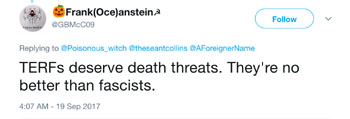 Transactivists verbally attack women (and anyone else) who disagrees with transideology with screams of “TERF” (i.e. Trans Exclusionary Radical Feminist). At times, these attacks include death threats and have spilled over into physical violence against women. Transactivists routinely and cruelly use tactics that should never be used against members of another minority, including intimidation, campaigns to discredit women or to get women fired, de-platforming, and silencing.
Transactivists verbally attack women (and anyone else) who disagrees with transideology with screams of “TERF” (i.e. Trans Exclusionary Radical Feminist). At times, these attacks include death threats and have spilled over into physical violence against women. Transactivists routinely and cruelly use tactics that should never be used against members of another minority, including intimidation, campaigns to discredit women or to get women fired, de-platforming, and silencing.
The ideology and activities of the transgender movement demonstrate a complete failure in their ability to respect and work with other oppressed groups, women in particular.
Even worse, the central premise of transideology encourages M2T people to claim that they are women.[3] This is an illegitimate claim, a theft of the identity that belongs to another oppressed minority, women. Cultural appropriation of the traditions of racial/ethnic minorities is a clearly understood ethical breech, so why should transgender people be permitted this identity grab?
Must Males Have Whatever They Want? M2T Persons Have Male Privilege!
Transactivists try to justify the claim that M2T persons can become women by attempting to remove biological sex (being female, not male) from the definition of woman. Sometimes M2T activists try to claim that they are female, but this is a tough sell since sex is biological and males lack the XX chromosomes needed to be female.
In western and most, probably all, societies, the primary qualification for being a woman is being of the female sex. Societies need the social category of “woman” in order to make a social distinction between the female and male sexes. The other qualification for being a woman that makes sense is having the experience of living as a girl or woman in a female body. M2T people can never be female and even if they attempt to live as women, their life experiences are those of a male pretending to be a woman.
Some people, including many in the transgender movement, consider adherence to female sex stereotypes to be relevant to being a woman, but this is problematic since sex stereotypes are made up (socially constructed) and are different in different societies and different time periods. For example, pink is now considered a “feminine” color, but this association only came about following World War II. In some cultures, now and in the past, sex roles have had survival value. In modern western industrialized societies sex stereotypes are useless and are limiting and harmful to everyone. The only possible claim that M2T persons have on womanhood is their compliance with harmful female sex role stereotypes.
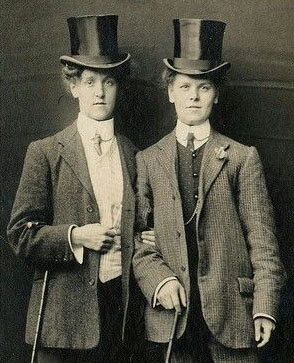 If males can be women (or female!), then being a woman loses any meaning other than being a person who complies with female sex stereotypes (and that leaves out many females who refuse to comply with those stereotypes). The transgender self-id laws currently being considered or passed in some states and countries essentially allow anyone who wants to say they are a woman to legally become a woman (and female).
If males can be women (or female!), then being a woman loses any meaning other than being a person who complies with female sex stereotypes (and that leaves out many females who refuse to comply with those stereotypes). The transgender self-id laws currently being considered or passed in some states and countries essentially allow anyone who wants to say they are a woman to legally become a woman (and female).
Hey! If males want to say they are women, then we can’t deny them what they want, can we? After all, they have male privilege!
Without Women’s Liberation, Everyone Loses
A big problem here is that women – the real women – are oppressed in western (and many other) societies based primarily on our biological sex. We (most of us women) are the ones who have the power to reproduce! The attempt to control human reproduction by controlling women is at the very heart of patriarchal society. 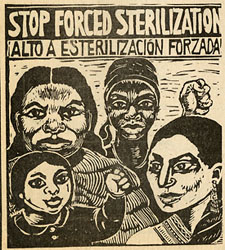 This is why abortion laws are highly contested, why contraception is under fire, why some societies are sterilizing women of color against their will. And much more.
This is why abortion laws are highly contested, why contraception is under fire, why some societies are sterilizing women of color against their will. And much more.
How are women to organize and resist our oppression if we no longer have a name and identity for our own group – women? The oppression of females will not disappear even if the category of “woman” becomes meaningless (because it includes males). Only our ability to recognize and resist our oppression will be eliminated.
Look at what is happening when women attempt to meet in women-only (female) groups! The closing down of women-only meetings and events is a primary goal of transactivism! And the transactivists are succeeding – most women-only events have been forced to move underground or semi-underground. The Women’s Liberation Movement is not even free to hold a public meeting!
The closing down of women-only meetings and events is a primary goal of transactivism. The Women’s Liberation Movement is not even free to hold a public meeting!
Klein tells us:
“Either we fight for a future in which everyone belongs, starting with those being most battered by injustice and exclusion today, or we will keep losing. And there is no time for that. Moreover, when we make these connections among issues (climate, capitalism, colonialism, white supremacy, and misogyny), there is a kind of relief. Because it actually is all connected, all part of the same story.” (p. 194, Naomi Klein, On Fire: The (Burning) Case for a Green New Deal)
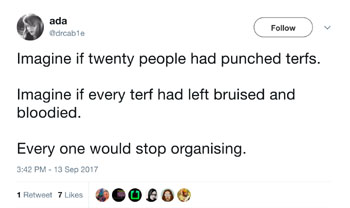 How are women to maintain our own liberation movement, let alone be powerful participants in coalitions to break the power of the forces destroying the earth? The social-economic system that is creating ecological disaster and human misery is primarily a product of the male imagination because that system has always been heavily male dominated. This system is not going to be undone without the contributions of radical feminists, the women who are specialists in understanding patriarchy. The use of the slur, “TERF,” against radical feminists is an assault against every resistance fighter and against the Earth since a broad resistance cannot succeed without radical feminism. Women’s hands must be untied if the resistance is to be successful.
How are women to maintain our own liberation movement, let alone be powerful participants in coalitions to break the power of the forces destroying the earth? The social-economic system that is creating ecological disaster and human misery is primarily a product of the male imagination because that system has always been heavily male dominated. This system is not going to be undone without the contributions of radical feminists, the women who are specialists in understanding patriarchy. The use of the slur, “TERF,” against radical feminists is an assault against every resistance fighter and against the Earth since a broad resistance cannot succeed without radical feminism. Women’s hands must be untied if the resistance is to be successful.
Where is the justice for women?
The social-economic system that is creating ecological disaster and human misery is primarily a product of the male imagination because that system has always been heavily male dominated. This system is not going to be undone without the contributions of radical feminists, the women who are specialists in understanding patriarchy.
“Trans is Trans” and Nothing More
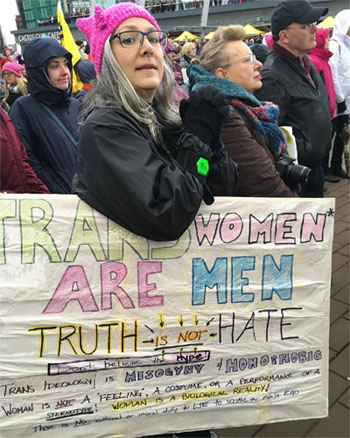 How will women get the justice we deserve with a rogue minority group at our throats and a misogynist Left helping transactivists tear into us? Klein is correct that we all need justice and that we all are needed in the fight to stop the capitalist, colonialist patriarchy destroying the planet. This need for justice includes transgender people, of course. Every feminist I know supports transgender people’s right to live free of violence, free from discrimination in jobs and housing, and free to act in any masculine or feminine way they want.
How will women get the justice we deserve with a rogue minority group at our throats and a misogynist Left helping transactivists tear into us? Klein is correct that we all need justice and that we all are needed in the fight to stop the capitalist, colonialist patriarchy destroying the planet. This need for justice includes transgender people, of course. Every feminist I know supports transgender people’s right to live free of violence, free from discrimination in jobs and housing, and free to act in any masculine or feminine way they want.
The problem is that M2T transactivists are not asking for simple justice, but to take more than is rightly theirs – women’s identity. As I’ve explained in an earlier blog, transgender people deserve exactly what every minority group deserves – fairness, together with an unspoiled group identity that allows them to claim power for their group and love and value themselves as members of their minority group. The transgender movement has missed the mark. The identity that rightly belongs to M2T people is their transgender identity, not women’s identity.
Fortunately transgender people and their movement are not all of one mind. Transgender people who disagree with the trans party line are subjected to nasty tactics from transactivists, but some are identifying as gender critical and speaking out. For example, the author(s) of the Transrational Manifesto say that “[w]e believe that the wisest course of action is to seek recognition in our own right – as trans people.” There’s more:
“1. Trans is Trans
Principally, we have chosen to build our philosophical foundation on the idea that trans people are neither men nor women, but a third category….
Transmen are transmen. They’re not men, and they’re not women.
Transwomen are transwomen. They’re not women, and they’re not men….”
(Transrational Manifesto)
Transrational clarifies their position about sex by saying, “Transwomen are not a variation of females, but of males.”
Working Together
 The feminist movement and a movement of transgender people embracing their transgender identity (and not grabbing anyone else’s identity) would have many concerns in common, especially with undoing harms caused by patriarchy and sex role stereotypes. Women and transgender people could be natural allies, just as gay men could be allies to Lesbians. But, these alliances require everyone under the GBTQ umbrella to drop their misogyny and focus on dismantling patriarchy (along with capitalism, racism, colonialism…). Women could certainly use the help in getting the entire network of resistance movements working with us to end patriarchy. The assaults on the Earth come from patriarchal social systems and patriarchy must be undone if we are to avert ecological disaster.
The feminist movement and a movement of transgender people embracing their transgender identity (and not grabbing anyone else’s identity) would have many concerns in common, especially with undoing harms caused by patriarchy and sex role stereotypes. Women and transgender people could be natural allies, just as gay men could be allies to Lesbians. But, these alliances require everyone under the GBTQ umbrella to drop their misogyny and focus on dismantling patriarchy (along with capitalism, racism, colonialism…). Women could certainly use the help in getting the entire network of resistance movements working with us to end patriarchy. The assaults on the Earth come from patriarchal social systems and patriarchy must be undone if we are to avert ecological disaster.
I’ll let Naomi Klein close up here (with a few asides from me in [brackets]):
“The bottom line is this: As we get clean [avert ecological disaster], we have got to get fair. More than that, as we get clean, we can begin to redress the founding crimes of our nations: Land theft, genocide, slavery [and gynocide] [4]. Yes, the hardest stuff. Because we haven’t just been procrastinating climate action all these years. We’ve been procrastinating and delaying the most basic demands of justice and reparation. And we are out of time on every front.”
(p. 201, Naomi Klein, On Fire: The (Burning) Case for a Green New Deal)
*****
Footnotes
1. See, for example, Radical Feminism: A Documentary Reader edited by Barbara A. Crow; This Bridge Called My Back: Writings by Radical Women of Color edited by Cherríe Moraga and Gloria Anzaldua; Nice Jewish Girls: A Lesbian Anthology edited by Evelyn Torton Beck; Shadow on a Tightrope: Writings by Women on Fat Oppression edited by Lisa Schoenfielder and Barb Wieser; Out of the Class Closet: Lesbians Speak edited by Julia Penelope; With the Power of Each Breath: A Disabled Women’s Anthology edited by Susan E. Browne, Debra Connors and Nanci Stern.
2. The 1.4 million figure is an estimate of the transgender population in the U.S. provided for 2014 by the pro-trans Williams Institute at UCLA. According to the Williams Institute, studies using data collected from 2003 through 2009 estimated about 700,000 transgender people in the U.S. I used 2011 because data were available about murder of both transgender people and women in the U.S. in that year. See https://transrespect.org/en/map/trans-murder-monitoring/?submap=tmm_2011 for murder statistics by country of transgender people from 2008 through mid 2016. See “Homicide in the U.S. Known to Law Enforcement, 2011” by Erica L. Smith and Alexia Cooper for homicide data on women and men in the U.S.
3. Females who become transgender are also falsely claiming an identity – being a man. However, this claim does not injure a minority group since men are the dominant group in this society. The situation of females and males who become transgender have very little in common. This blog post focuses primarily on the dynamics that result from males claiming to be women.
4. Definition of gynocide: “The fundamental intent of global patriarchy: planned, institutionalized spiritual and bodily destruction of women; the use of deliberate systematic measures (such as killing, bodily or mental injury, unliveable conditions, prevention of births), which are calculated to bring about the destruction of women as a political and cultural force, the eradication of Female/Bio-logical religion and language, and ultimately the extermination of the Race of Women and all Elemental being; the master model of genocide; paradigm for the systematic destruction of any racial, political, or cultural group.” (p. 77, Mary Daly with Jane Caputi, Websters’ First New Intergalactic Wickedary of the English Language)
 What is going on between the Georgia Greens and the Lavender Caucus? At their February meeting, the Georgia Greens modified their platform stating that policy makers should find nuanced approaches that can both protect trans-identified individuals and protect the sex-based rights of women. Among other changes, their Human Rights plank now concludes:
What is going on between the Georgia Greens and the Lavender Caucus? At their February meeting, the Georgia Greens modified their platform stating that policy makers should find nuanced approaches that can both protect trans-identified individuals and protect the sex-based rights of women. Among other changes, their Human Rights plank now concludes: As you might expect, the Lavender Greens were a bit ticked off! On February 28th in an “Open Letter to the National Committee of the Green Party of the United States” this LGBTQIA+ caucus argued that the Declaration on Women’s Sex-Based Rights would “force children to undergo permanent physical changes that exacerbate their dysphoria, inflicting trauma that could last the rest of their lives.” (Note that the “permanent physical changes the Lavender Greens are concerned about are those of going through a natural puberty!) The Lavender Greens go on to say they can’t “stand by while one of our state parties aligns itself with a hate group.” (And now note that the “hate group” they are speaking of is the Women’s Human Rights Campaign.) The Lavender Greens demand that the Georgia Greens:
As you might expect, the Lavender Greens were a bit ticked off! On February 28th in an “Open Letter to the National Committee of the Green Party of the United States” this LGBTQIA+ caucus argued that the Declaration on Women’s Sex-Based Rights would “force children to undergo permanent physical changes that exacerbate their dysphoria, inflicting trauma that could last the rest of their lives.” (Note that the “permanent physical changes the Lavender Greens are concerned about are those of going through a natural puberty!) The Lavender Greens go on to say they can’t “stand by while one of our state parties aligns itself with a hate group.” (And now note that the “hate group” they are speaking of is the Women’s Human Rights Campaign.) The Lavender Greens demand that the Georgia Greens: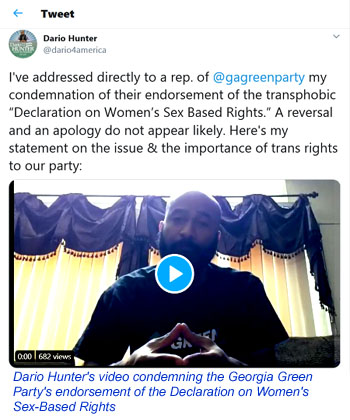 A letter on April 7th from the Georgia Greens to Dario Hunter provides a look at the unfolding conflict. Hunter is the delegate of the Lavender Caucus to the Green National Committee. He is also seeking the 2020 Green Party presidential nomination. Although Hunter published a video condemning the Georgia Greens, he still felt he could propose a “reconciliation retreat.” The Georgia Greens found Hunter’s terms unacceptable, replying:
A letter on April 7th from the Georgia Greens to Dario Hunter provides a look at the unfolding conflict. Hunter is the delegate of the Lavender Caucus to the Green National Committee. He is also seeking the 2020 Green Party presidential nomination. Although Hunter published a video condemning the Georgia Greens, he still felt he could propose a “reconciliation retreat.” The Georgia Greens found Hunter’s terms unacceptable, replying: 

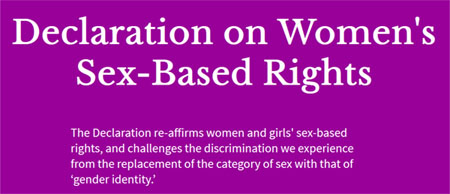
 We are standing up against the powerful people and corporations determined to maintain the deadly and profitable status quo.
We are standing up against the powerful people and corporations determined to maintain the deadly and profitable status quo. In her book,
In her book,  After all these many decades, feminists continue to struggle, as social divisions have proved incredibly difficult to bridge in societies rooted in privilege and division. Creating justice for all within the powerful global network of social movements envisioned by Naomi Klein and within the myriad of global societies is, perhaps, a task for a truly desperate people. Yet, desperate is what we are with the Earth at high risk.
After all these many decades, feminists continue to struggle, as social divisions have proved incredibly difficult to bridge in societies rooted in privilege and division. Creating justice for all within the powerful global network of social movements envisioned by Naomi Klein and within the myriad of global societies is, perhaps, a task for a truly desperate people. Yet, desperate is what we are with the Earth at high risk. Transactivists verbally attack women (and anyone else) who disagrees with transideology with screams of “TERF” (i.e. Trans Exclusionary Radical Feminist). At times, these attacks include
Transactivists verbally attack women (and anyone else) who disagrees with transideology with screams of “TERF” (i.e. Trans Exclusionary Radical Feminist). At times, these attacks include  If males can be women (or female!), then being a woman loses any meaning other than being a person who complies with female sex stereotypes (and that leaves out many females who refuse to comply with those stereotypes). The transgender self-id laws currently being considered or passed in some states and countries essentially allow anyone who wants to say they are a woman to legally become a woman (and female).
If males can be women (or female!), then being a woman loses any meaning other than being a person who complies with female sex stereotypes (and that leaves out many females who refuse to comply with those stereotypes). The transgender self-id laws currently being considered or passed in some states and countries essentially allow anyone who wants to say they are a woman to legally become a woman (and female).  This is why abortion laws are highly contested, why contraception is under fire, why some societies are sterilizing women of color against their will. And much more.
This is why abortion laws are highly contested, why contraception is under fire, why some societies are sterilizing women of color against their will. And much more. How are women to maintain our own liberation movement, let alone be powerful participants in coalitions to break the power of the forces destroying the earth? The social-economic system that is creating ecological disaster and human misery is primarily a product of the male imagination because that system has always been heavily male dominated. This system is not going to be undone without the contributions of radical feminists, the women who are specialists in understanding patriarchy. The use of the slur, “TERF,” against radical feminists is an assault against every resistance fighter and against the Earth since a broad resistance cannot succeed without radical feminism. Women’s hands must be untied if the resistance is to be successful.
How are women to maintain our own liberation movement, let alone be powerful participants in coalitions to break the power of the forces destroying the earth? The social-economic system that is creating ecological disaster and human misery is primarily a product of the male imagination because that system has always been heavily male dominated. This system is not going to be undone without the contributions of radical feminists, the women who are specialists in understanding patriarchy. The use of the slur, “TERF,” against radical feminists is an assault against every resistance fighter and against the Earth since a broad resistance cannot succeed without radical feminism. Women’s hands must be untied if the resistance is to be successful.  How will women get the justice we deserve with a rogue minority group at our throats and a misogynist Left helping transactivists tear into us? Klein is correct that we all need justice and that we all are needed in the fight to stop the capitalist, colonialist patriarchy destroying the planet. This need for justice includes transgender people, of course. Every feminist I know supports transgender people’s right to live free of violence, free from discrimination in jobs and housing, and free to act in any masculine or feminine way they want.
How will women get the justice we deserve with a rogue minority group at our throats and a misogynist Left helping transactivists tear into us? Klein is correct that we all need justice and that we all are needed in the fight to stop the capitalist, colonialist patriarchy destroying the planet. This need for justice includes transgender people, of course. Every feminist I know supports transgender people’s right to live free of violence, free from discrimination in jobs and housing, and free to act in any masculine or feminine way they want. The feminist movement and a movement of transgender people embracing their transgender identity (and not grabbing anyone else’s identity) would have many concerns in common, especially with undoing harms caused by patriarchy and sex role stereotypes. Women and transgender people could be natural allies, just as gay men could be allies to Lesbians. But, these alliances require everyone under the GBTQ umbrella to drop their misogyny and focus on dismantling patriarchy (along with capitalism, racism, colonialism…). Women could certainly use the help in getting the entire network of resistance movements working with us to end patriarchy. The assaults on the Earth come from patriarchal social systems and patriarchy must be undone if we are to avert ecological disaster.
The feminist movement and a movement of transgender people embracing their transgender identity (and not grabbing anyone else’s identity) would have many concerns in common, especially with undoing harms caused by patriarchy and sex role stereotypes. Women and transgender people could be natural allies, just as gay men could be allies to Lesbians. But, these alliances require everyone under the GBTQ umbrella to drop their misogyny and focus on dismantling patriarchy (along with capitalism, racism, colonialism…). Women could certainly use the help in getting the entire network of resistance movements working with us to end patriarchy. The assaults on the Earth come from patriarchal social systems and patriarchy must be undone if we are to avert ecological disaster. 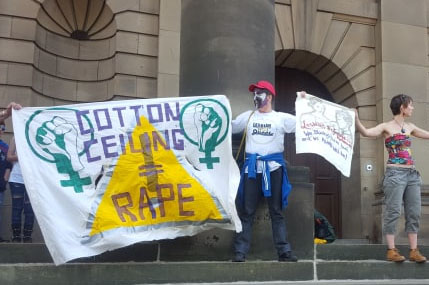
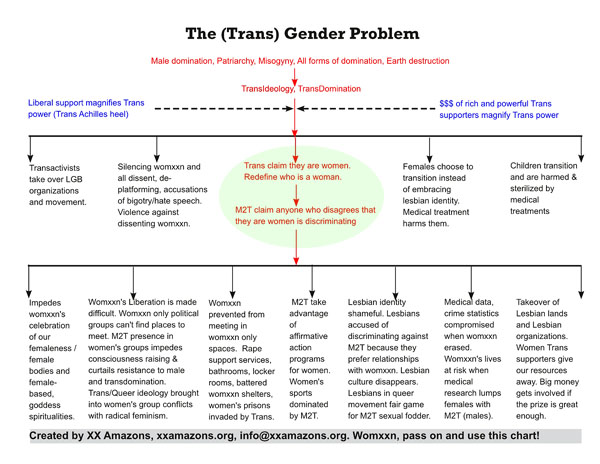
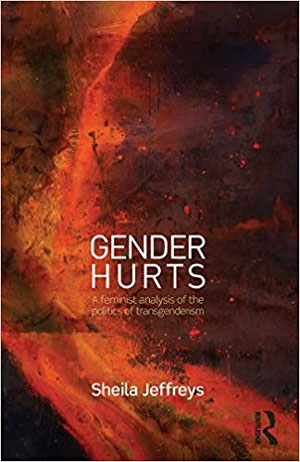 Sheila Jeffreys traced the origins of the concept of “gender identity” in her book, Gender Hurts. In the 1950s and 1960s the medical profession became increasingly engaged with males who wanted to take advantage of advancing medical technologies in endrocrinology and surgery to become transsexual. At that time, the medical profession could not agree on what kinds of treatments were ethical. Some medical professionals strongly believed that treatment should be limited to psychological methods. The sexologists who offered physical treatment hit upon the use of the word “gender” to justify the harms they were inflicting on healthy bodies. Jeffreys quotes Bernice Hausman, who explained in her book, Changing Sex, Transsexuality, Technology and the Idea of Gender, that this justification required “construction of a rhetorical system that posits a prior gendered self.” (p. 27, Gender Hurts) Hausman described gender as “the idea of an identity prior to and within the body that theoretically should dictate the appearance of the subject.” (p. 27, Gender Hurts) (Note: the word “gender” was being used then, but today, “gender identity” would be used.)
Sheila Jeffreys traced the origins of the concept of “gender identity” in her book, Gender Hurts. In the 1950s and 1960s the medical profession became increasingly engaged with males who wanted to take advantage of advancing medical technologies in endrocrinology and surgery to become transsexual. At that time, the medical profession could not agree on what kinds of treatments were ethical. Some medical professionals strongly believed that treatment should be limited to psychological methods. The sexologists who offered physical treatment hit upon the use of the word “gender” to justify the harms they were inflicting on healthy bodies. Jeffreys quotes Bernice Hausman, who explained in her book, Changing Sex, Transsexuality, Technology and the Idea of Gender, that this justification required “construction of a rhetorical system that posits a prior gendered self.” (p. 27, Gender Hurts) Hausman described gender as “the idea of an identity prior to and within the body that theoretically should dictate the appearance of the subject.” (p. 27, Gender Hurts) (Note: the word “gender” was being used then, but today, “gender identity” would be used.) The “born that way” ideology still provides many medical practitioners and researchers with a meal ticket. The work of these professionals props up gender identity ideology. Consider
The “born that way” ideology still provides many medical practitioners and researchers with a meal ticket. The work of these professionals props up gender identity ideology. Consider 
 Good news can be hard to come by in the U.S. fight against trans domination. But, it is time to celebrate! Radical feminists and gender critical allies just made a quantum leap forward!
Good news can be hard to come by in the U.S. fight against trans domination. But, it is time to celebrate! Radical feminists and gender critical allies just made a quantum leap forward! 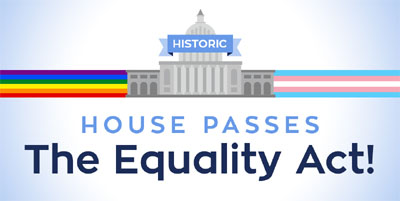
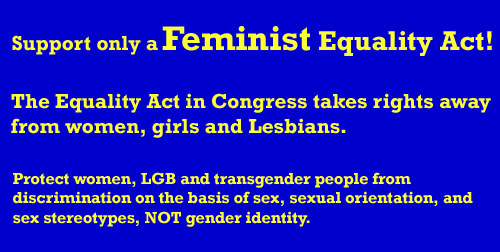
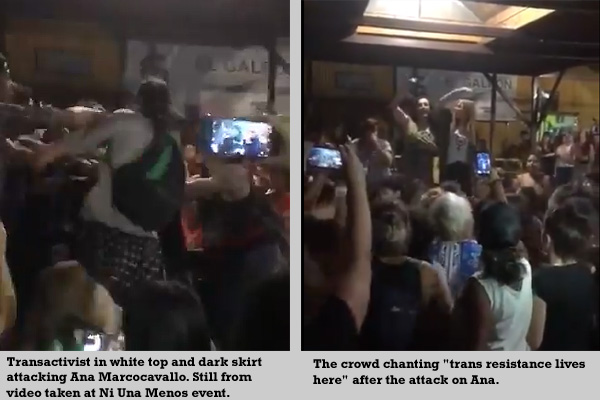
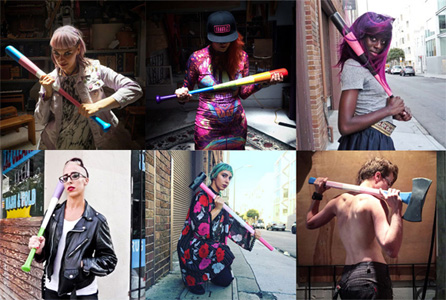 But, the physical violence of a few was supported by surrounding crowds of trans and queer, mostly young, people. This crowd support for physical violence is one terrible example of the culture promoting attacks on women that permeates TQ activism. I won’t describe that attack culture right now – most or maybe all of you are familiar with it anyway – but I will point out that the
But, the physical violence of a few was supported by surrounding crowds of trans and queer, mostly young, people. This crowd support for physical violence is one terrible example of the culture promoting attacks on women that permeates TQ activism. I won’t describe that attack culture right now – most or maybe all of you are familiar with it anyway – but I will point out that the  The TQ culture likewise damages the girls and women who join that culture. Lesbians are
The TQ culture likewise damages the girls and women who join that culture. Lesbians are  What inconsistency could be more dramatic for a feminist than the realization that the TQ movement she strongly supports has created a culture promoting attacks on women? I tested the waters by talking to a small group of women who are hard core believers in the trans narrative about the San Francisco Dyke March and the TQ culture of violence against women.
What inconsistency could be more dramatic for a feminist than the realization that the TQ movement she strongly supports has created a culture promoting attacks on women? I tested the waters by talking to a small group of women who are hard core believers in the trans narrative about the San Francisco Dyke March and the TQ culture of violence against women.
